Colmirc
- Mafia Page -
Gambino
Gambino Family
In the late 1920s, the boss of the gang that would come to be known
as the Gambino Family was Al Mineo, one of Joe "The Boss" Masseria's
strong supporters in the Castellammarese War. Unfortunately for
Mineo, he was one of Masseria's supporters that was killed in 1930,
leading to Masseria's downfall.
 A capo in the gang, Frank Scalise (right), was made boss after
Mineo. Scalise had joined forces with Maranzano earlier in the war,
but when Charles "Lucky" Luciano had Maranzano killed, Scalise was
thought to be too close to Maranzano.
A capo in the gang, Frank Scalise (right), was made boss after
Mineo. Scalise had joined forces with Maranzano earlier in the war,
but when Charles "Lucky" Luciano had Maranzano killed, Scalise was
thought to be too close to Maranzano.  Scalise's gang did not want a war with Luciano, so Scalise was
persuaded to step down, and Vince Mangano was elected boss. Mangano
(left) had also switched to Maranzano's side during the war, but he
was seen as a better choice than Scalise. Mangano was one of the
seven original members of the Commission. In fact, he served as
chairman, probably due to the fact that his Family was the largest of
the seven. Mangano chose the notorious Albert Anastasia as his
underboss.
Scalise's gang did not want a war with Luciano, so Scalise was
persuaded to step down, and Vince Mangano was elected boss. Mangano
(left) had also switched to Maranzano's side during the war, but he
was seen as a better choice than Scalise. Mangano was one of the
seven original members of the Commission. In fact, he served as
chairman, probably due to the fact that his Family was the largest of
the seven. Mangano chose the notorious Albert Anastasia as his
underboss.
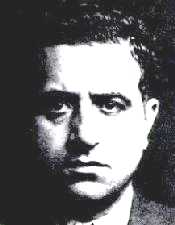 Thomas Dewey, the District Attorney and a famous mob buster, posed a
threat to the mob. In the 1930s, Anastasia suggested to kill Dewey.
This was against La Cosa Nostra rules, so Mangano shot down
Anastasia's suggestion, embarassing him. In 1951, Mangano disappeared
and his brother's body was found. Anastasia (right) took over
position of boss.
Thomas Dewey, the District Attorney and a famous mob buster, posed a
threat to the mob. In the 1930s, Anastasia suggested to kill Dewey.
This was against La Cosa Nostra rules, so Mangano shot down
Anastasia's suggestion, embarassing him. In 1951, Mangano disappeared
and his brother's body was found. Anastasia (right) took over
position of boss.
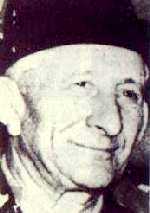 Anastasia was closely allied with Frank Costello, the Genovese boss.
This had been a powerful alliance, but it turned out to be a
two-edged sword. Vito Genovese had been plotting with Tommy Lucchese
and Anastasia's underboss, Carlo Gambino (left). Their objective:
take out both Costello and Anastasia leaving Genovese in Costello's
position as boss of his Family and Gambino in Anastasia's position as
boss of his Family.
Anastasia was closely allied with Frank Costello, the Genovese boss.
This had been a powerful alliance, but it turned out to be a
two-edged sword. Vito Genovese had been plotting with Tommy Lucchese
and Anastasia's underboss, Carlo Gambino (left). Their objective:
take out both Costello and Anastasia leaving Genovese in Costello's
position as boss of his Family and Gambino in Anastasia's position as
boss of his Family.
 In May 1957, Costello was shot and wounded by Vincent "The Chin"
Gigante (below left) and quickly decided to retire. This left
Anastasia without his ally. In June 1957, Frank Scalise (former boss
but now Anastasia's underboss) was gunned down. This scene was
recreated in the movie The Godfather.
In May 1957, Costello was shot and wounded by Vincent "The Chin"
Gigante (below left) and quickly decided to retire. This left
Anastasia without his ally. In June 1957, Frank Scalise (former boss
but now Anastasia's underboss) was gunned down. This scene was
recreated in the movie The Godfather. 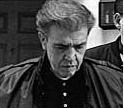 To complete the plot, in October 1957, Anastasia was killed in a
barbershop (right). Gambino became boss.
To complete the plot, in October 1957, Anastasia was killed in a
barbershop (right). Gambino became boss.
Three years later, Lucchese, Genovese, and Gambino began plotting
against Joe Bonanno and Joe Profaci, the bosses of the other two New
York Families. Profaci died of cancer leaving Joe Magliocco as the
new boss, but he failed to unite the Family. Bonanno and Magliocco
plotted the murders of Gambino and Lucchese, but their plan was
discovered. Magliocco eventually died, and Bonanno lost his
power.
 In 1967, Lucchese died, leaving Gambino as the most powerful boss on
the Commission, to say the least. Gambino controlled his own Family,
plus the other four bosses sought to appease him. Joe Colombo, boss
of Profaci's old Family, attempted to start some disagreement, but a
lone assassain killed him. His killer was then killed at the scene,
so his motives were never discovered.
In 1967, Lucchese died, leaving Gambino as the most powerful boss on
the Commission, to say the least. Gambino controlled his own Family,
plus the other four bosses sought to appease him. Joe Colombo, boss
of Profaci's old Family, attempted to start some disagreement, but a
lone assassain killed him. His killer was then killed at the scene,
so his motives were never discovered.
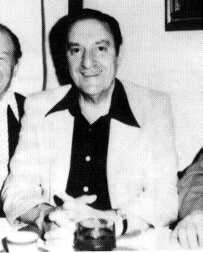 In 1976, Gambino's poor health led him to choose a replacement. He
chose Big Paul Castellano (left) over his underboss, Aniello
Dellacroce. Dellacroce accepted this in true La Cosa Nostra fashion.
Actually, by now, it must appear that this was not La Cosa Nostra
fashion. Anyway, Castellano reigned for the next 9 years, but in
1985, he was gunned down (above right) outside Sparks Steak House in
Manhattan amid the hustle and bustle of Christmas shoppers.
In 1976, Gambino's poor health led him to choose a replacement. He
chose Big Paul Castellano (left) over his underboss, Aniello
Dellacroce. Dellacroce accepted this in true La Cosa Nostra fashion.
Actually, by now, it must appear that this was not La Cosa Nostra
fashion. Anyway, Castellano reigned for the next 9 years, but in
1985, he was gunned down (above right) outside Sparks Steak House in
Manhattan amid the hustle and bustle of Christmas shoppers.
 Some of the crews that reported to Dellacroce suggested that Big Paul
thought of himself as a businessman more than a gangster and was
selling the Family out. He was no longer in touch with what happened
on the streets and ran his construction businesses from his isolated
mansion. This led to feelings of ill will by some crews. In addition,
a ruthless capo named John Gotti (left) was beginning to feel
that he and his crew were in danger due to some government tapes that
revealed their heroin dealing. Castellano was a supporter of
Gambino's rule that drug dealers would be punished with death. To
make matters worse, Castellano did not like Gotti, and Dellacroce,
who did like Gotti, was dying. When Dellacroce died, Gotti knew he
had to put a rush on his plans. Gotti brought other Family members
into his scheme, including a powerful soldier named Salvatore "Sammy
the Bull" Gravano and his crew. He also obtained unofficial approval
from the Lucchese, Bonanno, and Colombo Families. Castellano was
killed -- Gotti became boss.
Some of the crews that reported to Dellacroce suggested that Big Paul
thought of himself as a businessman more than a gangster and was
selling the Family out. He was no longer in touch with what happened
on the streets and ran his construction businesses from his isolated
mansion. This led to feelings of ill will by some crews. In addition,
a ruthless capo named John Gotti (left) was beginning to feel
that he and his crew were in danger due to some government tapes that
revealed their heroin dealing. Castellano was a supporter of
Gambino's rule that drug dealers would be punished with death. To
make matters worse, Castellano did not like Gotti, and Dellacroce,
who did like Gotti, was dying. When Dellacroce died, Gotti knew he
had to put a rush on his plans. Gotti brought other Family members
into his scheme, including a powerful soldier named Salvatore "Sammy
the Bull" Gravano and his crew. He also obtained unofficial approval
from the Lucchese, Bonanno, and Colombo Families. Castellano was
killed -- Gotti became boss.
 Gotti adapted to the role of boss well. Almost overnight, he went
from being a thug to wearing $2000 suits and $200 handpainted ties.
He loved the attention that the media was giving him, and the media
finally had a celebrity gangster. As testament to his popularity, a
portrait of him by Andy Warhol even graced the cover of Time
Magazine (below right). He was called the Dapper Don (above left)
and, walking away from three prosecutions, the Teflon Don. He was
also establishing an intimidating reputation in the world of La Cosa
Nostra.
Gotti adapted to the role of boss well. Almost overnight, he went
from being a thug to wearing $2000 suits and $200 handpainted ties.
He loved the attention that the media was giving him, and the media
finally had a celebrity gangster. As testament to his popularity, a
portrait of him by Andy Warhol even graced the cover of Time
Magazine (below right). He was called the Dapper Don (above left)
and, walking away from three prosecutions, the Teflon Don. He was
also establishing an intimidating reputation in the world of La Cosa
Nostra.  Anyone showing disapproval was killed.
Anyone showing disapproval was killed.
The F.B.I. finally caught up with Johnny Boy, who had been taped
on several occasions talking about murder and racketeering as well as
the bribing of jurors and police detectives. This, coupled with the
surprising cooperation and testimony of Sammy Bull Gravano (left),
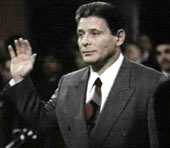 now Gotti's underboss, proved too much for the Teflon Don. On April
2, 1992, John Gotti was found guilty of all 14 counts in the
indictment against him, including the murders of Paul Castellano,
Tommy Bilotti, and Robert DiBernardo. Gotti was sentenced to life
without the possibility of parole, and on June 24, 1992, was
delivered to the federal penitentiary in Marion, Illinois. The
Justice Department's ballpark estimate of what it had cost to make
the Gotti case and bring it to trial: $75 million and seven years.
Sammy Bull Gravano is the highest ranking member of La Cosa Nostra to
break omerta and his story is told in Peter Maas' book
Underboss. You may be interested to know that Sammy Bull
admitted to playing a major part in some 19 murders. For these
murders, he served a little over four years in prison before entering
the federal witness protection program. Sammy Bull is now on his own,
works a day job, and lives in Tucson (see article).
now Gotti's underboss, proved too much for the Teflon Don. On April
2, 1992, John Gotti was found guilty of all 14 counts in the
indictment against him, including the murders of Paul Castellano,
Tommy Bilotti, and Robert DiBernardo. Gotti was sentenced to life
without the possibility of parole, and on June 24, 1992, was
delivered to the federal penitentiary in Marion, Illinois. The
Justice Department's ballpark estimate of what it had cost to make
the Gotti case and bring it to trial: $75 million and seven years.
Sammy Bull Gravano is the highest ranking member of La Cosa Nostra to
break omerta and his story is told in Peter Maas' book
Underboss. You may be interested to know that Sammy Bull
admitted to playing a major part in some 19 murders. For these
murders, he served a little over four years in prison before entering
the federal witness protection program. Sammy Bull is now on his own,
works a day job, and lives in Tucson (see article).
Gotti planned to run his Family from prison, but by 1996, the
Commission asked Gotti to step down. John A. (Junior) Gotti, Gotti's
son, is believed to be acting boss, but he holds none of the power of
his father. In addition, he began a prison sentence for racketeering
in July 1999. Prosecutors, however, believe that his father still
runs the Family.

John Gotti in his prison cell in Marion, Illinois.
Home
 A capo in the gang, Frank Scalise (right), was made boss after
Mineo. Scalise had joined forces with Maranzano earlier in the war,
but when Charles "Lucky" Luciano had Maranzano killed, Scalise was
thought to be too close to Maranzano.
A capo in the gang, Frank Scalise (right), was made boss after
Mineo. Scalise had joined forces with Maranzano earlier in the war,
but when Charles "Lucky" Luciano had Maranzano killed, Scalise was
thought to be too close to Maranzano.  Scalise's gang did not want a war with Luciano, so Scalise was
persuaded to step down, and Vince Mangano was elected boss. Mangano
(left) had also switched to Maranzano's side during the war, but he
was seen as a better choice than Scalise. Mangano was one of the
seven original members of the Commission. In fact, he served as
chairman, probably due to the fact that his Family was the largest of
the seven. Mangano chose the notorious Albert Anastasia as his
underboss.
Scalise's gang did not want a war with Luciano, so Scalise was
persuaded to step down, and Vince Mangano was elected boss. Mangano
(left) had also switched to Maranzano's side during the war, but he
was seen as a better choice than Scalise. Mangano was one of the
seven original members of the Commission. In fact, he served as
chairman, probably due to the fact that his Family was the largest of
the seven. Mangano chose the notorious Albert Anastasia as his
underboss. Thomas Dewey, the District Attorney and a famous mob buster, posed a
threat to the mob. In the 1930s, Anastasia suggested to kill Dewey.
This was against La Cosa Nostra rules, so Mangano shot down
Anastasia's suggestion, embarassing him. In 1951, Mangano disappeared
and his brother's body was found. Anastasia (right) took over
position of boss.
Thomas Dewey, the District Attorney and a famous mob buster, posed a
threat to the mob. In the 1930s, Anastasia suggested to kill Dewey.
This was against La Cosa Nostra rules, so Mangano shot down
Anastasia's suggestion, embarassing him. In 1951, Mangano disappeared
and his brother's body was found. Anastasia (right) took over
position of boss. Anastasia was closely allied with Frank Costello, the Genovese boss.
This had been a powerful alliance, but it turned out to be a
two-edged sword. Vito Genovese had been plotting with Tommy Lucchese
and Anastasia's underboss, Carlo Gambino (left). Their objective:
take out both Costello and Anastasia leaving Genovese in Costello's
position as boss of his Family and Gambino in Anastasia's position as
boss of his Family.
Anastasia was closely allied with Frank Costello, the Genovese boss.
This had been a powerful alliance, but it turned out to be a
two-edged sword. Vito Genovese had been plotting with Tommy Lucchese
and Anastasia's underboss, Carlo Gambino (left). Their objective:
take out both Costello and Anastasia leaving Genovese in Costello's
position as boss of his Family and Gambino in Anastasia's position as
boss of his Family. In May 1957, Costello was shot and wounded by Vincent "The Chin"
Gigante (below left) and quickly decided to retire. This left
Anastasia without his ally. In June 1957, Frank Scalise (former boss
but now Anastasia's underboss) was gunned down. This scene was
recreated in the movie The Godfather.
In May 1957, Costello was shot and wounded by Vincent "The Chin"
Gigante (below left) and quickly decided to retire. This left
Anastasia without his ally. In June 1957, Frank Scalise (former boss
but now Anastasia's underboss) was gunned down. This scene was
recreated in the movie The Godfather.  To complete the plot, in October 1957, Anastasia was killed in a
barbershop (right). Gambino became boss.
To complete the plot, in October 1957, Anastasia was killed in a
barbershop (right). Gambino became boss. In 1967, Lucchese died, leaving Gambino as the most powerful boss on
the Commission, to say the least. Gambino controlled his own Family,
plus the other four bosses sought to appease him. Joe Colombo, boss
of Profaci's old Family, attempted to start some disagreement, but a
lone assassain killed him. His killer was then killed at the scene,
so his motives were never discovered.
In 1967, Lucchese died, leaving Gambino as the most powerful boss on
the Commission, to say the least. Gambino controlled his own Family,
plus the other four bosses sought to appease him. Joe Colombo, boss
of Profaci's old Family, attempted to start some disagreement, but a
lone assassain killed him. His killer was then killed at the scene,
so his motives were never discovered. In 1976, Gambino's poor health led him to choose a replacement. He
chose Big Paul Castellano (left) over his underboss, Aniello
Dellacroce. Dellacroce accepted this in true La Cosa Nostra fashion.
Actually, by now, it must appear that this was not La Cosa Nostra
fashion. Anyway, Castellano reigned for the next 9 years, but in
1985, he was gunned down (above right) outside Sparks Steak House in
Manhattan amid the hustle and bustle of Christmas shoppers.
In 1976, Gambino's poor health led him to choose a replacement. He
chose Big Paul Castellano (left) over his underboss, Aniello
Dellacroce. Dellacroce accepted this in true La Cosa Nostra fashion.
Actually, by now, it must appear that this was not La Cosa Nostra
fashion. Anyway, Castellano reigned for the next 9 years, but in
1985, he was gunned down (above right) outside Sparks Steak House in
Manhattan amid the hustle and bustle of Christmas shoppers. Some of the crews that reported to Dellacroce suggested that Big Paul
thought of himself as a businessman more than a gangster and was
selling the Family out. He was no longer in touch with what happened
on the streets and ran his construction businesses from his isolated
mansion. This led to feelings of ill will by some crews. In addition,
a ruthless capo named John Gotti (left) was beginning to feel
that he and his crew were in danger due to some government tapes that
revealed their heroin dealing. Castellano was a supporter of
Gambino's rule that drug dealers would be punished with death. To
make matters worse, Castellano did not like Gotti, and Dellacroce,
who did like Gotti, was dying. When Dellacroce died, Gotti knew he
had to put a rush on his plans. Gotti brought other Family members
into his scheme, including a powerful soldier named Salvatore "Sammy
the Bull" Gravano and his crew. He also obtained unofficial approval
from the Lucchese, Bonanno, and Colombo Families. Castellano was
killed -- Gotti became boss.
Some of the crews that reported to Dellacroce suggested that Big Paul
thought of himself as a businessman more than a gangster and was
selling the Family out. He was no longer in touch with what happened
on the streets and ran his construction businesses from his isolated
mansion. This led to feelings of ill will by some crews. In addition,
a ruthless capo named John Gotti (left) was beginning to feel
that he and his crew were in danger due to some government tapes that
revealed their heroin dealing. Castellano was a supporter of
Gambino's rule that drug dealers would be punished with death. To
make matters worse, Castellano did not like Gotti, and Dellacroce,
who did like Gotti, was dying. When Dellacroce died, Gotti knew he
had to put a rush on his plans. Gotti brought other Family members
into his scheme, including a powerful soldier named Salvatore "Sammy
the Bull" Gravano and his crew. He also obtained unofficial approval
from the Lucchese, Bonanno, and Colombo Families. Castellano was
killed -- Gotti became boss. Gotti adapted to the role of boss well. Almost overnight, he went
from being a thug to wearing $2000 suits and $200 handpainted ties.
He loved the attention that the media was giving him, and the media
finally had a celebrity gangster. As testament to his popularity, a
portrait of him by Andy Warhol even graced the cover of Time
Magazine (below right). He was called the Dapper Don (above left)
and, walking away from three prosecutions, the Teflon Don. He was
also establishing an intimidating reputation in the world of La Cosa
Nostra.
Gotti adapted to the role of boss well. Almost overnight, he went
from being a thug to wearing $2000 suits and $200 handpainted ties.
He loved the attention that the media was giving him, and the media
finally had a celebrity gangster. As testament to his popularity, a
portrait of him by Andy Warhol even graced the cover of Time
Magazine (below right). He was called the Dapper Don (above left)
and, walking away from three prosecutions, the Teflon Don. He was
also establishing an intimidating reputation in the world of La Cosa
Nostra.  Anyone showing disapproval was killed.
Anyone showing disapproval was killed. now Gotti's underboss, proved too much for the Teflon Don. On April
2, 1992, John Gotti was found guilty of all 14 counts in the
indictment against him, including the murders of Paul Castellano,
Tommy Bilotti, and Robert DiBernardo. Gotti was sentenced to life
without the possibility of parole, and on June 24, 1992, was
delivered to the federal penitentiary in Marion, Illinois. The
Justice Department's ballpark estimate of what it had cost to make
the Gotti case and bring it to trial: $75 million and seven years.
Sammy Bull Gravano is the highest ranking member of La Cosa Nostra to
break omerta and his story is told in Peter Maas' book
Underboss. You may be interested to know that Sammy Bull
admitted to playing a major part in some 19 murders. For these
murders, he served a little over four years in prison before entering
the federal witness protection program. Sammy Bull is now on his own,
works a day job, and lives in Tucson (see article).
now Gotti's underboss, proved too much for the Teflon Don. On April
2, 1992, John Gotti was found guilty of all 14 counts in the
indictment against him, including the murders of Paul Castellano,
Tommy Bilotti, and Robert DiBernardo. Gotti was sentenced to life
without the possibility of parole, and on June 24, 1992, was
delivered to the federal penitentiary in Marion, Illinois. The
Justice Department's ballpark estimate of what it had cost to make
the Gotti case and bring it to trial: $75 million and seven years.
Sammy Bull Gravano is the highest ranking member of La Cosa Nostra to
break omerta and his story is told in Peter Maas' book
Underboss. You may be interested to know that Sammy Bull
admitted to playing a major part in some 19 murders. For these
murders, he served a little over four years in prison before entering
the federal witness protection program. Sammy Bull is now on his own,
works a day job, and lives in Tucson (see article).